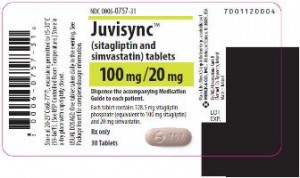November is Diabetes Awareness Month and with it comes the announcement of a new combination drug to help battle the growing disease. It’s called Juvisync, and it’s the first cholesterol and diabetes combination drug of its kind. Being that high cholesterol and diabetes tend to go hand in hand for those with Type 2 diabetes, this drug promises to eliminate two birds with one stone.
 Type 2 diabetics often have many other conditions such as high cholesterol and high blood pressure. It is important that these areas are as closely managed as their blood sugar to prevent complications like stroke and heart attack.
Type 2 diabetics often have many other conditions such as high cholesterol and high blood pressure. It is important that these areas are as closely managed as their blood sugar to prevent complications like stroke and heart attack.
Healthy goals for diabetic patients for blood pressure should be less than 130/80 and LDL cholesterol levels, a.k.a. “bad cholesterol,” is less than 100 mg/dL and sometimes even less than 70 mg/dL. Juvisync’s aim is to help patients reach their goal and cut down on their daily pill count.
Juvisync is a combination tablet of Januvia and simvastatin. Januvia is a recently approved medication for Type 2 diabetics that helps lower high blood sugar by enhancing the body’s ability to produce insulin. Januvia is not designed for someone who is a Type 1 diabetic because they do not produce their own insulin. Some of the secondary functions of Januvia are helping the body use insulin and decrease glucose production from the liver. When Januvia is used in combination with insulin or other diabetic medications it could possibly result in low blood sugar. Other side effects include risk of upper respiratory infections, swelling of the nose and throat and headaches. Possible GI side effects could include nausea, abdominal pain and diarrhea.
Simvastatin helps reduce LDL cholesterol. Lowering LDL cholesterol can help prevent stroke and heart attack. Side effects from simvastatin can include constipation, heartburn, stomach pain and gas. More severe side effects that would require talking to a doctor include dark urine and muscle aches. Recent evidence has shown that 80 mg dosages are making patients more susceptible to muscle toxicity so currently 5, 10, 20 and 40 mg are acceptable starting doses.
 Both these medications are approved to help cholesterol and blood sugar in combination with a healthy diet and exercise. The FDA has currently approved 100/10 (Januvia/simvastatin), 100/20 and 100/40 milligrams. Doses of 50 mg of Januvia with simvastatin are currently under the approval process.
Both these medications are approved to help cholesterol and blood sugar in combination with a healthy diet and exercise. The FDA has currently approved 100/10 (Januvia/simvastatin), 100/20 and 100/40 milligrams. Doses of 50 mg of Januvia with simvastatin are currently under the approval process.
Combination drugs can be helpful in providing results to patients and helping them become more adherent to their therapy with less pills to remember to take. The downside to combination medications is the inability to adjust the dosage of one medication or the other. If the patient needs a higher amount of simvastatin they could not double up on their Juvisync because they would be taking too much of the Januvia portion and risk complications like low blood sugar.
If patients follow doctor and pharmacists instructions, Juvisync could be the start of many combination products for diabetic patients that could possibly control blood pressure, diabetes and cholesterol. The combinations and possibilities could be endless.
Also Read:
Diabetes Rates to Triple by 2050
